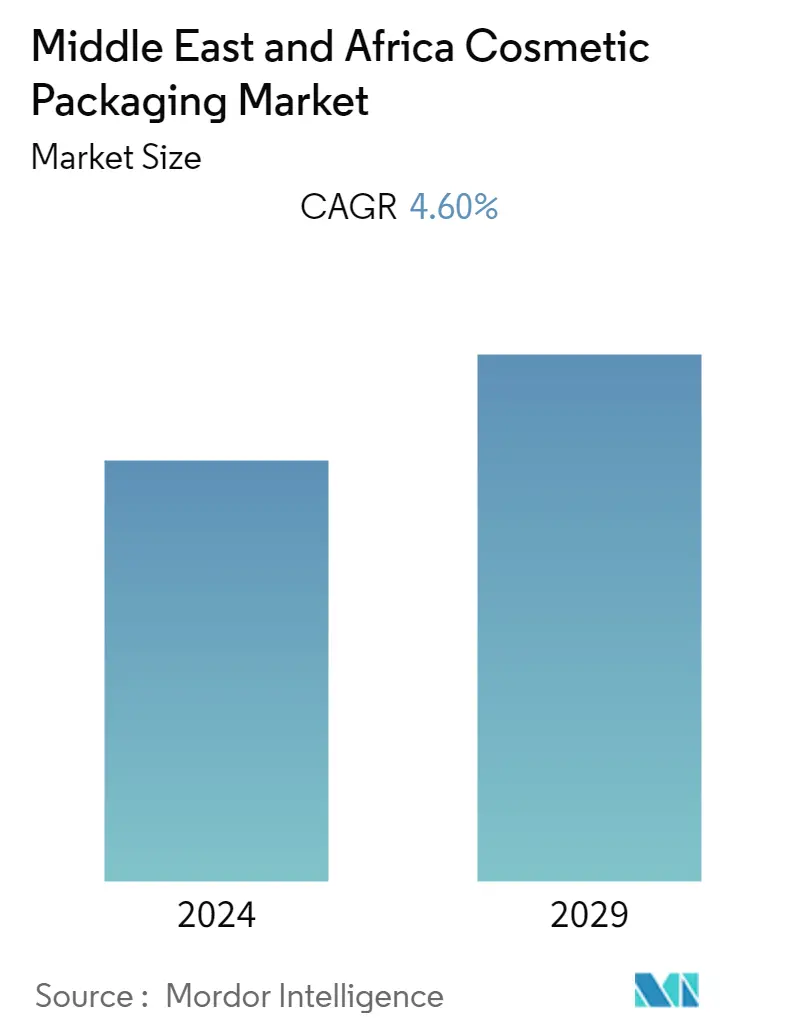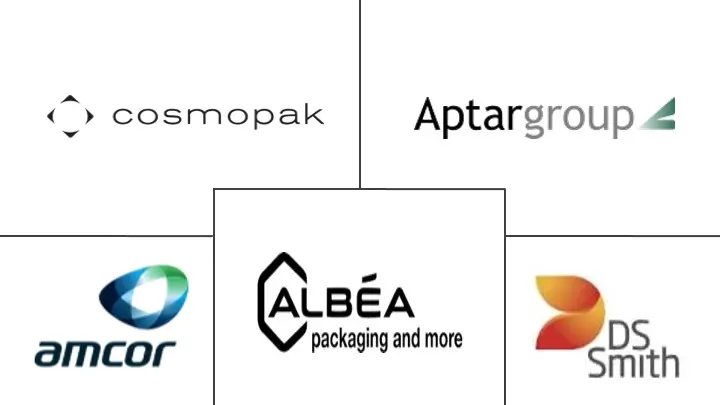Market Size of Middle East and Africa Cosmetic Packaging Industry

| Study Period | 2019 - 2029 |
| Base Year For Estimation | 2023 |
| Forecast Data Period | 2024 - 2029 |
| Historical Data Period | 2019 - 2022 |
| CAGR | 4.60 % |
| Market Concentration | Medium |
Major Players
*Disclaimer: Major Players sorted in no particular order |
MEA Cosmetic Packaging Market Analysis
The Middle East and Africa Cosmetic Packaging Market is estimated to grow at a CAGR of about 4.6% over the forecast period 2020 to 2025. The cosmetic packaging market is driven by the proliferation in demand for cosmetic products, primarily due to increasing spending powers in the region, including Saudi Arabia and the United Arab Emirates, among others. Additionally, certain factors, such as the youthful population, increasing product availability, and increasing consumer awareness in the countries, are expected to play a significant role in the market's growth.
- Saudi Arabia has depicted one of the highest rates of cosmetics consumption in the MEA region and is also dominating the consumption of skin and hair care products. Consumers in Saudi Arabia are inclined to spend large sums on their appearance, which is expected to supplement the cosmetic industry; hence, in-turn increasing the demand for cosmetic packaging in the region.
- Also, the increasing adoption of cosmetics due to the increase in disposable income in the region is further expected to stimulate the value of these products' aesthetic value. Also, the increasing penetration of social media and e-commerce websites in the country proliferates the demand for cosmetic products, hence, stimulating the adoption of cosmetic packaging products.
- Further, the cosmetics industry in the region is gradually stepping up to combat excess packaging's major problem. Multiple brands are becoming more aware of the damage caused by the usage of single-use plastic. Eco-friendly beauty brands are now letting the users refill their empty shampoo and perfume bottles, such as Le Labo's hand-blended fragrances and cult-favorite Santal 33. The product is bottled in a clear glass jar with pared-back labels. The product comes packaged in a recyclable cardboard box. The brand is also offering an in-store service that enables its users to refill their empty fragrance bottle for a maximum discount of up to 20%.
- Moreover, in Mar 2020, the Environment Agency of Abu Dhabi (EAD), the largest environmental regulator in the Middle East, announced that it aims to eliminate avoidable single-use plastic usage non-plastic materials by the year 2021 by fostering a culture of recycling and re-use. These initiatives by the government are expected to affect the market significantly.
- The recent outbreak of coronavirus has affected the market causing major supply chain disruptions. However, initiatives led by multiples companies coupled with the increasing government political commitments and investments aligning to the initiative such as Saudi Vision 2030 are expected to drive the market. For instance, in Mar 2020, the Riyadh Municipality distributed free sanitation products across the city as part of their ongoing efforts to contain the coronavirus outbreak. The government officials will be handing out the products at traffic lights and in several mosques around the city. With the approval of the Saudi Food and Drug Authority, the municipality announced that it had increased the production of sanitizers and disinfectants.
MEA Cosmetic Packaging Industry Segmentation
This study characterizes the cosmetic packaging market, based on the type of packaging which includes Plastic, Glass, Metal, and Paper. The scope of this study is currently focused on regions across the Middle East and Africa.
| Material type | |
| Plastic | |
| Glass | |
| Metal | |
| Paper |
| Product Type | |
| Plastic Bottles and Containers | |
| Glass Bottles and Containers | |
| Metal Containers | |
| Folding Cartons | |
| Corrugated Boxes | |
| Tubes and Sticks | |
| Caps and Closures | |
| Pump and Dispenser | |
| Droppers | |
| Ampoules | |
| Flexible Plastic Packaging |
| Cosmetic Type | |
| Hair Care | |
| Color Cosmetics | |
| Skin Care | |
| Men's Grooming | |
| Deodorants | |
| Other Cosmetic Types (Fragrances, Depilatories, Baby and Child Care, and Sun Care) |
| Country | |
| United Arab Emirates | |
| Saudi Arabia | |
| South Africa | |
| Rest of Middle East and Africa |
Middle East and Africa Cosmetic Packaging Market Size Summary
The Middle East and Africa cosmetic packaging market is experiencing growth driven by increased demand for cosmetic products, fueled by rising disposable incomes and consumer spending in countries like Saudi Arabia and the United Arab Emirates. The region's youthful population, coupled with greater product availability and heightened consumer awareness, is further propelling market expansion. Saudi Arabia stands out as a significant consumer of cosmetics, particularly in skin and hair care, with a strong inclination towards spending on personal appearance. This trend is bolstered by the growing influence of social media and e-commerce, which are enhancing the accessibility and appeal of cosmetic products, thereby increasing the demand for innovative packaging solutions.
The market is also witnessing a shift towards sustainable packaging, influenced by environmental concerns and government regulations aimed at reducing plastic usage. Initiatives such as the Environment Agency of Abu Dhabi's efforts to eliminate single-use plastics and the adoption of eco-friendly packaging by brands like Le Labo are shaping industry practices. The introduction of sustainable packaging technologies and the preference for glass over plastic are notable trends. Additionally, the market is moderately competitive, with global and regional players investing in the region to capitalize on its growth potential. Companies are focusing on enhancing packaging aesthetics and functionality to meet the evolving consumer preferences and regulatory standards, thereby driving the market forward.
Middle East and Africa Cosmetic Packaging Market Size - Table of Contents
-
1. MARKET DYNAMICS
-
1.1 Market Overview
-
1.2 Industry Value Chain Analysis
-
1.3 Industry Attractiveness - Porter's Five Force Analysis
-
1.3.1 Bargaining Power of Suppliers
-
1.3.2 Bargaining Power of Consumers
-
1.3.3 Threat of New Entrants
-
1.3.4 Threat of Substitutes
-
1.3.5 Intensity of Competitive Rivalry
-
-
1.4 Market Drivers
-
1.4.1 Increasing Focus on Innovation and Attractive Packaging
-
-
1.5 Market Restraints
-
1.5.1 Growing Sustainability Concerns
-
-
-
2. MARKET SEGMENTATION
-
2.1 Material type
-
2.1.1 Plastic
-
2.1.2 Glass
-
2.1.3 Metal
-
2.1.4 Paper
-
-
2.2 Product Type
-
2.2.1 Plastic Bottles and Containers
-
2.2.2 Glass Bottles and Containers
-
2.2.3 Metal Containers
-
2.2.4 Folding Cartons
-
2.2.5 Corrugated Boxes
-
2.2.6 Tubes and Sticks
-
2.2.7 Caps and Closures
-
2.2.8 Pump and Dispenser
-
2.2.9 Droppers
-
2.2.10 Ampoules
-
2.2.11 Flexible Plastic Packaging
-
-
2.3 Cosmetic Type
-
2.3.1 Hair Care
-
2.3.2 Color Cosmetics
-
2.3.3 Skin Care
-
2.3.4 Men's Grooming
-
2.3.5 Deodorants
-
2.3.6 Other Cosmetic Types (Fragrances, Depilatories, Baby and Child Care, and Sun Care)
-
-
2.4 Country
-
2.4.1 United Arab Emirates
-
2.4.2 Saudi Arabia
-
2.4.3 South Africa
-
2.4.4 Rest of Middle East and Africa
-
-
Middle East and Africa Cosmetic Packaging Market Size FAQs
What is the current Middle East and Africa Cosmetic Packaging Market size?
The Middle East and Africa Cosmetic Packaging Market is projected to register a CAGR of 4.60% during the forecast period (2024-2029)
Who are the key players in Middle East and Africa Cosmetic Packaging Market?
Amcor PLC, Albéa Group, Cosmopak Corporation, DS Smith PLC and AptarGroup Inc are the major companies operating in the Middle East and Africa Cosmetic Packaging Market.

